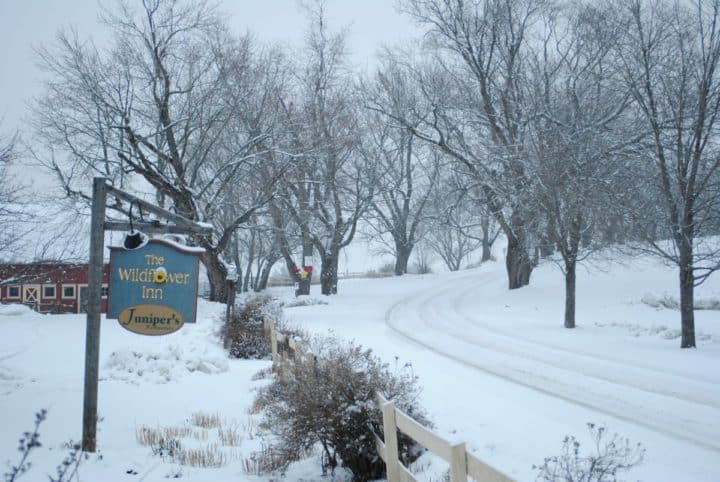This post contains references to products from one or more of our advertisers. We may receive compensation when you click on links to those products. For an explanation of our Advertising Disclosure, visit this page.
A vehicle breakdown is always a recipe for having a bad day. But being stranded in a faraway place while traveling can be a nightmare. Thorough vehicle inspections before a road trip can help you enjoy a trouble-free vacation. Here’s what to look for in your car check before a road trip to have more peace of mind.

Check Your Engine Fluid Levels
One of the first things to look for on your car check before your road trip is your fluid levels. Inspecting your fluid levels can help you determine if you need an oil change. Fortunately, you can easily check these car fluids at home:
- Engine oil
- Power steering fluid
- Brake fluid
- Windshield washer fluid
Each dipstick has a max fill and minimum fill line. “Topping off” each fluid is a good idea if you’re near the bottom line.
Depending on how many miles you have until your next engine oil change, being proactive and changing your oil early can be worth the cost. Changing your engine oil is a good idea if it’s been one year since your last visit. Most oil change facilities will top off your other fluids at no additional charge.
Some mechanics may also do a quick multi-points card inspection to look for other potential issues including:
- Brake pads and rotors
- Tire pressure
- Tire tread depth
- Wheel alignment
- Air conditioning freon levels
- Engine air filter
- Windshield wipers
- Engine belt wear and tear
- Car battery connections
You can inspect these other levels by yourself, but it can be easier to have a mechanic. Keeping cars safe is their job, after all.
Most newer automobiles have a “sealed automatic transmission.” If your car has a transmission fluid dipstick, check that fluid level as well.
Inspect Your Vehicle Exterior
Another important tip when conducting your car check before a road trip is to walk around your vehicle and look at the exterior parts. You might want to give extra attention to the following features on your vehicle or car rental.
Wiper Blades
Pay close attention to your windshield wiper blades. You can buy replacements at an auto parts store like AutoZone or discount stores such as Walmart.
Tire Inspection
Also, inspect your tire pressure and look for abnormal wear patterns on your tires. You might decide to replace your tires before leaving if they are close to needing replacing or have poor traction in rain and snow. Don’t forget to inflate your spare tire if your vehicle has one.
If you buy your tires from Costco or Sam’s Club, you may want to check out their credit cards that earn rewards on purchases. They also offer some of the best gas credit cards available.
Do the “Penny Test” on Your Tires
One way to check your tire tread at home is by using a penny. Place Lincoln’s head upside down so the top of the penny touches the tire in between two tread lines. Consider replacing your tires soon if you can see his forehead when testing between several lines as you only have 2/16-inch or less remaining.
You can also try this with a quarter. Seeing the top of President Washington’s heads indicates your tires are near the end of their life.
Headlights
One final exterior safety feature to inspect is your headlights, taillights, and turn signals. Replace any bulbs that have burnt-out if you have the capability. Some cars require a mechanic with special tools to replace car lights.
Schedule Preventative Maintenance
Your vehicle owner’s manual suggests planned maintenance based on your current mileage. These suggested maintenance intervals can double as your road trip car maintenance schedule.
Having the mechanic perform certain repairs or replacements can be worth it. Ideally, schedule this work at least one or two weeks before starting your road trip. This lead time can be enough time to see if the mechanic needs to inspect their recent work.
Sometimes, mechanics get faulty parts or may need to make some adjustments after you “break-in” the replacement part.
Fix Check Engine Lights and Vehicle Recalls
Leaving town with a constant check engine light or an open vehicle recalls can be nerve-wracking if something happens.
You can enter your vehicle’s VIN number with the National Highway Traffic Safety Administration to check for open recalls. The car manufacturer should mail you paper notices as well. Try scheduling repairs before you leave town. However, the dealership may have to wait for parts or might be too busy to schedule a last-minute appointment.
Ask yourself this question if you’re trying to decide if your car is safe to drive. Is it safe to drive with the check engine light on? The answer might be yes if you’re going a short distance and have a loose fuel cap. You should strongly consider seeing a mechanic if you have fouled spark plugs or a bad sensor.
If you cannot get the necessary repairs complete in time, renting a car might be better if you own a high mileage vehicle. You avoid further wear and tear on the car that may require you to visit a repair shop on your road trip. Or, consider using an RV rental service, such as RVshare.
The rental fees can cost less than potential repairs, towing costs, and booking a hotel room. Plus, if you have a card that comes with primary rental insurance perks, such as the Chase Sapphire Preferred® Card, you won’t have to worry about buying extra insurance on your rental. However, if renting an RV, note that RV insurance is likely going to have to be a separate purchase.
Related: Chase Sapphire Rental Car Insurance Benefits Guide
Clean the Vehicle Interior
A clean-looking and pleasant smelling interior can keep your anxiety levels low if you don’t like dirty surfaces. Cleaning your windows and rearview mirror can improve your visibility. Driving with dirty inside windows when there is a strong sun glare or reflection from other cars can have an enhanced blinding effect.
Don’t Forget to Organize Your Car
One question you most likely won’t ask when cleaning the inside of your car is, “How do I organize my car for a long trip?” Organizing what’s inside your car can prevent an accident or another safety hazard.
For instance, slamming on your brakes to a sudden stop lunges every loose object forward. Items under your seat like water bottles or disinfectant wipes can go behind the pedals.
Putting everything in its proper place, like the center console, means you’re not trying to look in random places while driving. You’re more likely to swerve into another lane (or off the road) if you’re not fully focused on the driving.
Having a clean and organized interior and trunk are can also mean you have more storage space and legroom.
Pack an Emergency Kit
Does your road trip packing list include an emergency kit?
Most cars leave the assembly line with a basic safety kit to repair flat tires. Perhaps your kit can fix other basic mechanical breakdowns too. If not, you can purchase an additional kit from Amazon or a local auto parts store.
Your kit should include these basic items:
- Battery jumper cables
- First aid kit
- Reflective warning triangles or emergency flares
- Tire repair tools
You might also consider adding roadside assistance to your car insurance policy. Reviewing car insurance guides and resources can help you find the best option for you. Basic coverage usually costs less than $5 per month and can save you a few hundred in towing costs or service costs.
Related: Best Credit Cards With Roadside Assistance Protection Benefits
Summary of Your Car Check Before a Road Trip
You can most likely perform an adequate vehicle inspection before a road trip. Taking it to a mechanic can give you additional peace of mind and the costs can be reasonable. It’s wise to prepare your car for a road trip several weeks before you go in case you need to make an unexpected repair.
Related: Best credit cards for everyday spending
FAQs
How do I know if my car is ready for a long trip?
This road trip checklist can prepare your car for a long-distance journey:
- Recent engine oil change
- Top off engine fluid levels (i.e. power steering, brake fluid, and windshield washer fluid)
- Car battery and alternator pass a charging test
- Adequate tire pressure, tread depth and wheel alignment
- Brake pads and brake rotors have sufficient life
- No unresolved check engine codes or vehicle recalls
- The preventative maintenance schedule is current
- Windshield wipers work properly
- All exterior lights function
- No other erratic or intermittent issues that impact vehicle safety or reliability
- Have an emergency roadside kit (in the event of an incident or breakdown)
Remember that a mechanical breakdown can happen at any time to a new or old car. But taking as many preventative measures possible reduces the risk of getting stranded in a strange place.
How long can I drive on a spare tire?
Many new cars only come with a run-flat tire or a “slime kit.” These kits and run-flat tires can withstand a leak but you must head directly to a tire repair place. Count your blessings if your care has a spare tire as this amenity is becoming less common.
Roadside assistance mechanics will respond if you have a spare tire that needs air. However, you will need to call a tow truck if you don’t have a functional spare and your flat tire is irreparable (i.e. an expensive breakdown).
However, most spare tires these days are a “donut spare” and not a full-size spare. This tire is narrower and smaller so you must drive at a slower speed. For instance, your maximum speed may only be 50 miles per hour. This is the minimum driving speed on federal interstate highways but slower than most people drive.
Also, donut spares have a relatively short maximum driving distance. The manufacturer may only recommend that you drive up to 100 miles on the spare.
You should replace your tires at the next town where you might have to stay overnight if you get a flat tire on a road trip. Having all four tires of the same size means your car is safer to drive. Your vehicle’s driving performance is reduced when you have mismatched tires. Many cars disable certain safety sensors too while you have a flat.
How long can you drive on a bad alternator?
If your car won’t start or won’t stay running, you might have a bad battery or alternator. Most national auto parts stores will test your car battery and alternator for free.
If you have a bad alternator, your car battery doesn’t charge. Once the battery exhausts its remaining charge level, various warning lights may illuminate, your car may display other erratic behavior and eventually turn off as a self-protection measure. On a full charge, you might be able to safely drive for up to four hours.
To be extra cautious, you should drive no more than 100 miles with a bad alternator.
A mechanic will need to replace your alternator. Depending on how far you drive on a bad alternator, you may have to replace your car battery too. Fully depleting a battery can cause it to improperly charge or not hold a charge overnight.
Related Articles:







